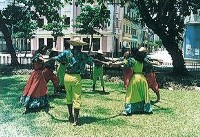|
|
Ciranda - regional dance or Pernambuco
«Recife
«Entertainment in Recife and Pernambuco
«Culture of Pernambuco
«Carnival in Recife
«Carnival in Olinda
 Ciranda:
Ciranda:
The ciranda is a typical dance of the beaches. More especially, the beaches situated in the north of the state of Pernambuco. However, the origins of this dance are not restricted merely to the coastal regions. Most of the research surrounding ciranda, reveals that the dance would seem to have appeared almost simultaneously both in the coastal regions and other regions in the interior of the state, particularly the north of the Zona-da Mata. When the dance first began, it was generally restricted to very popular, working class meeting places, such as beaches, bars, street corners etc. The participants were basically agricultural workers, fishermen, brick layers, and odd-job men, and the like.
In etymological terms, the word "ciranda" has been the subject of many differing interpretations. For the Catholic priest, Jaime Diniz, a pioneer in the study of ciranda, the word originates from the Spanish word Zaranda, which is a utensil for sifting flour, which in turn, had evolved from an Arabic word - arand. This theory is also confirmed by Caldas Aulete, in his Contemporary Dictionary of the Portuguese Language.
The maracas or the two drums, mentioned above, are the basic instruments of the traditional ciranda. Sometimes, it is possible to find a cuica (a kind of squeaky drum), o pandeiro (a kind of small tambourine/ drum), an accordion, or some kind of wind instrument. The songs that the master sings can either be already established songs (of his own composition or that of other masters), improvisations or even popular, well known commercial songs transformed into the rhythm of ciranda.
The steps of the dance vary according to the spirit of the particular dance in action, which is not necessarily definitive. There are three main steps which feature: a onda - the wave, o sacudidinho - the little shake and o machucadinho - the little crushing step.
There is also no limit to the number of people who can participate in the dance. Generally, the dance begins with a small circle of just a few people, which steadily grows as other people begin to join in. These "latecomers", without any kind of special ceremony, merely insert themselves into the ring by separating and holding the hands of the original participants. Should a participant need to leave the circle through tiredness, or any other motive, then he or she leaves in exactly the same way that he or she entered. If and when the circle of dancers becomes too large, and the movement becomes restricted, then another smaller circle is created in the center of the original circle. The simple objective of this dance is - happiness for everyone!
Click the next link to listen to a sample of ciranda (click button at the bottom of next page).
Source: The city of Recife.
| |